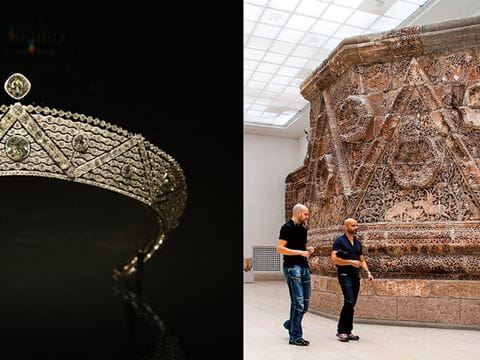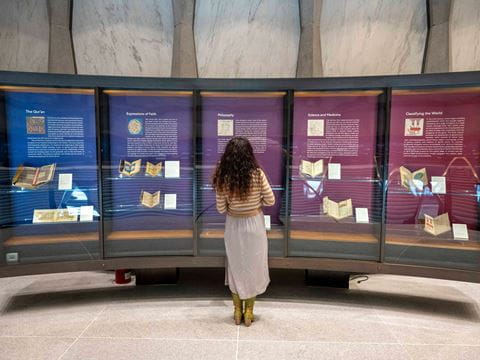
Zakir Hussain Played Tabla in Indian Classical Music and Beyond
While mastery of Indian musical traditions is one clear accomplishment, the late Zakir Hussain’s bold pursuit of his art across genres likely best defines his legacy.
Across genres Zakir Hussain was a master player of the tabla, a pair of small hand drums fundamental to classical music of northern India, Pakistan and Bangladesh since the 18th century. Here he performs during the True People’s Celebration in Chichibu, Japan.
The sounds of Indian classical music flowed into jazz, American folk and popular music, modern dance and percussive virtuosity worthy of the man being honored, the late tabla maestro Zakir Hussain. In San Francisco, California’s Grace Cathedral, a parade of musicians took the stage wielding guitars, sitar, violin, banjo, saxophones and all manner of drums and other percussion instruments, summoning a mesmerizing flow of deeply felt music that lasted over four hours.
Throughout these performances, few words were spoken. Only at the end did Hussain’s widow, Antonia Minnecola, take the stage to thank all involved. “Tonight,” she said, “we stormed the gates of heaven.” The gathered thousands, including Hussain’s students, collaborators and admirers in this city, where he spent much of his life, erupted in thunderous applause.
Born in Mumbai, India, Hussain was the son of Alla Rakha, the tabla player who accompanied sitar virtuoso Ravi Shankar in introducing Indian classical music to the United States and much of the world beginning in the 1950s.

A tabla choir performs during a celebration of life for Hussain in San Francisco, California. (Photo by Banning Eyre)
A child prodigy, Hussain began playing tabla at age 7 and was touring with masters on par with his father by age 12. By his own account, he walked around Mumbai with a boom box on his shoulder, listening to The Beatles, The Doors, Jimi Hendrix and more. When his father was too ill to travel to the US for a 1969 concert with Shankar, 19-year-old Hussain took his place and his transformational global journey began.
When Hussain died unexpectedly of a rare respiratory illness in December 2024, he was widely seen as the greatest and most consequential tabla player who ever lived. His undeniable command of the demanding traditions of both North and South Indian classical music became a stepping-off point for seemingly endless forays into other traditions, from jazz to bluegrass, Latin music to hip-hop. So while mastery of Indian classical traditions is one clear accomplishment Hussain leaves behind, it is likely his boldness in pursuing collaborations with a diverse range of musicians and in a variety of genres that best defines his legacy.
The concert at Grace spoke to that in a commemorative ritual, interweaving dazzling virtuosity from both Indian classical musicians as well as legendary American musicians: Béla Fleck on banjo; jazz performers Joshua Redman, Charles Lloyd, Steve Smith and others; an ensemble of drummers led by Mickey Hart of the Grateful Dead; and Abigail Washburn singing the Charles Wesley hymn “And Am I Born to Die,” glorious and unamplified, her voice resounding through the cathedral’s towering inner sanctum.
“All the Indian classical musicians that play all over the world ... definitely owe something to Zakir.”

Béla Fleck and Abigail Washburn perform a tribute to their late musical colleague. (Photo by Banning Eyre)
Zakir Hussain’s influence
Over five decades in the US, Hussain’s music career expanded across a variety of ensembles.
Among the first American musicians Hussain connected with in the early ’70s was drummer, bandleader and musicologist Mickey Hart. In his 1990 book, Drumming at the Edge of Magic, Hart notes Hussain’s virtuosity, but the true revelation was the way Hussain revealed the tabla’s “palette of emotional expression.” Hart had organized a concert for Hussain and his Indian classical ensemble and been changed by the experience. “I was stunned,” he recalled. “Once I sat back and I was rolling tape, I realized what was going down here. They were playing for each other.”
In the 1970s Hussain also worked with guitarist John Mclaughlin and Indian violinist L. Shankar in the ensemble Shakti. A high summit of virtuosity and structured improvisation, Shakti redefined jazz fusion as a global music movement. The ensemble continued to re-emerge in new formations right up to the year of Hussain’s death.

Antonia Minnecola, Hussain’s widow, thanks those who staged the concert. (Photo by Banning Eyre)
In 1999, Karsh Kale, Hussain and maverick producer, multi-instrumentalist and label owner Bill Laswell fused tradition and electronic music on the album and touring ensemble Tabla Beat Science. Kale is an Indian American tabla player and a pioneer of the Asian Underground movement, a fusion of electronica and various Eastern traditions. He, like many musicians, has collaborated and studied with Hussain over the years. “There was definitely an era before Zakir and after Zakir,” says Kale.
Indian classical music is a tradition in which each new generation absorbs the innovations of its predecessors and tries to exceed them, Kale notes. “All the Indian classical musicians that play all over the world, not only tabla players, definitely owe something to Zakir.”
Kale was a rock, pop and jazz-fusion drummer who began to study tabla only as an adult and after hearing Hussain. Hussain’s curiosity constantly compelled him to conquer new creative territory. What Kale calls his eagerness “to jump out of the box and speak many languages at the same time” was both thrilling and empowering.

Hussain sings with his father, noted tabla player Alla Rakha, with whom he recorded an album. (Courtesy Of Antonia Minnecola)
Hussain found a kindred spirit in banjo player and composer Fleck, an artist also known for his cross-genre forays. Fleck emerged from the bluegrass world and recalls that his peers were, frankly, intimidated by Shakti.
Summoning courage in 2003, Fleck and bassist/composer Edgar Meyer approached Hussain about collaborating on a classical composition for the new Shermerhorn Symphony Center in Nashville. “It was crazy,” recalls Fleck. “If Edgar and I worked on something, it would take us months because it was a lot of slow-moving and contradicting each other. But with Zakir in the room, all of a sudden, decisions got made, and they were good decisions.” The result was a concerto called “The Melody of Rhythm,” and from there, Hussain and Fleck became friends and co-creators for life. “Zakir always considered what he played to be melodic,” says Fleck. “Every note was bubbling. I really believe he felt that they were all pitches.”
Fleck ranks Hussain at the top of all the musicians he’s performed with over a varied career. “As an accompanist, his job was to get the best out of the soloist. ‘What is he trying to accomplish? What can I do to help?’ Zakir instinctively knew how far to push a musician, where your edges were, what you couldn’t go past.”

Salar Nader, left, studied under and performed with Hussain for 36 years. (Courtesy Of Salar Nader)
Fleck says Hussain made him a better player. “I call it the Magic Carpet Ride. His sense of time was so delicate and fine I could just relax. We could just sail.” Fleck admired Hussain’s informality, both off and on stage, evidenced in his commitment to giving every audience a good time. Hussain would toss in a melody from “The Lone Ranger Theme” or Beethoven’s Fifth Symphony in the middle of a dazzling tabla solo. “Some people might say that’s cheesy,” says Fleck. “But it brought a lot of people to him.”
In collaboration with Fleck and others, in 2024 Hussain won three of his four Grammy awards, including one for Shakti’s final album, “This Moment.”
For Fleck, losing Hussain was devastating, “like falling off a cliff.” He says the best way he can carry forth Hussain’s legacy is to mentor and inspire musicians, as Hussain did.
As much as Hussain ventured beyond the known boundaries of Indian classical music, he was also an unrivaled exemplar of an august tradition. In this capacity, he mentored some of the greatest tabla players of our time.

Hussain performs with the Symphony Orchestra of India in 2015 in Mumbai. (Kunal Patil/Hindustan Times via Getty Images)
The legacy and protégés
One of Hussain’s protégés is Salar Nader. He encountered Hussain as a child in Berkley, California, at age 7. “I basically walked into Zakirji’s classroom in 1988 as a 7-year-old,” recalls Nader. (Adding “ji” to the end of a name demonstrates respect.) “He was teaching summer tabla classes twice a week.”
A young boy among adult students, Nader might easily have felt cowed, but from that first encounter, Nader was struck by Hussain’s gentle, “childlike” manner, his skill as a “psychologist,” immediately sensing what each student needed and the best way to teach them. So began Nader’s life of study, mentorship and friendship with Hussain, which would last for the next 36 years.
Nader had grown up in a musical household, immersed in Central Asian folk and classical traditions, including tapes of Hussain performances.

Hussain and Sanjoy Roy, left, director of Teamwork Arts, take part in a speaker session on music at the Zee Jaipur (India) Literature Festival in 2018. (Raj K Raj/Hindustan Times via Getty Images)
“It was incredible to have lived in the times of Zakir Hussain.”
Today, Nader is one of the most accomplished tabla players alive. He performs with top-flight artists from Central Asia, as well as with jazz group Stanley Clarke Band.
The legacy Nader and other longtime students carry forward begins with tradition, complex classical compositions—some Hussain’s own, some passed down from bygone gurus. “We’re still trying to crack the code,” says Nadar.
From there, Hussain encouraged even his classical students to extend the range of the tabla, which he called “a limitless instrument.” When Nader became the first tabla player to perform on Broadway, in a production of “The Kite Runner,” Hussain was thrilled, proudly telling Nader, “You’ve created your own lane.” And it continued with Nader’s forays into hip-hop rhythms, jazz and more.
Another longtime classical student of Hussain is Amit Kavthekar, who also performed at Grace Cathedral. Kavthekar began studying tabla in Mumbai when he was 5. Showing talent, he was sent to study with Hussain’s father.

From left, Zakir Hussain, Edgar Meyer and Rakesh Chaurasia accept the Grammy Award for global music performance for the song "Pashto" in 2024. (Robert Gauthier/Los Angeles Times via Getty Images)
When Rakha died in 2000, Kavthekar began studying with Hussain. This was challenging in India because he was such a star. “There are always hundreds of people around him,” Kavthekar recalled. But after moving to Boston in 2010, Kavthekar spent focused time with his teacher.
He witnessed Hussain playing with Indian masters but also with Fleck, McLaughlin and others. All this enlarged his concept of tabla. He mastered the tradition and continues to accompany top-flight classical artists, but in 2021 he also joined jazz guitarist Al Di Meola’s group.
Among the deepest skills Kavthekar learned from Hussain is the ability to sense the needs of each situation and adjust accordingly. “Onstage,” recalls Kavthekar, “one day he’s playing with Béla Fleck, and the next day he’s playing hardcore Indian classical music. Then again, he’s playing with a symphony, and every time his playing changed, sometimes loud, sometimes very soft for a whole concert.” He adds, “You never felt that he was thinking about himself as the most important person on the stage.”

Hussain’s albums include, from left: “Together,” 1990; “Global Drum Project,” 2007; “Tabla and Beyond,” 2019; and “As We Speak,” 2023. (Dipa Chakraborty/Pacific Press/LightRocket via Getty Images)
Roshni Samlal came to Indian classical music through an unusual route. She was born in Trinidad, a descendant of Indian migrants. When the family moved to the US in 1997, she was familiar with giants of the tabla, including Hussain.
Samlal blossomed from this homespun musical life to a professional career when she joined a musicians’ collective very much of the Hussain era, Brooklyn Raga Massive. Hussain was a crucial model for Brooklyn Raga Massive, which began as a series of jam sessions in the spirit of Hussain, a classical virtuoso who was also free to experiment with Mickey Hart, get down with Chuck D, or a Western classical or jazz ensemble. This openness was a revelation for Samlal.
“A lot of us were students, and some were tabla players who would play with sitar players, and we would all show up at the jam session. It was a safe space where you could try out the material, and organically, people started calling each other for gigs. I realized that a tabla player could also be an ensemble leader.”

Surrounded by fans in Kolkata, India, Hussain signs autographs after a Tata Steel Kolkata Literary Meet in 2023.
Samlal met Hussain when she was a teenager, but in Hussain’s last year of life, she attended one of his intensive workshops. She had once heard Hussain explain the guru-student relationship this way: “The guru is a fast-flowing river. A student is just trying to get a cup of the water from that river that’s always just traveling and kind of in flux.”
For all he accomplished, Hussain knew that there are still many people around the world who have no notion of the tabla, and that drives a sense of mission for Hussain’s protégés, as it did for Hussain himself. Minnecola, his widow, now leads the Zakir Hussain Institute, dedicated to keeping her husband’s legacy alive. “As a start,” she says, “we’ll be continuing his teaching and archiving his performances and workshops.”
For his protégés, Hussain was a gift. “It is incredible to have lived in the times of Zakir Hussein,” says Nader.
That was certainly the consensus at Grace Cathedral. Hussain had planned a busy itinerary for 2025. Instead, a global cadre of artists and followers embraces the challenge of creating anew in the post Zakir Hussain era.
You may also be interested in...

Cartier and Islamic Design’s Enduring Influence
Arts
For generations Cartier looked to the patterns, colors and shapes of the Islamic world to create striking jewelry.
Mundane to Magnificent: Yale Manuscript Exhibition Illuminates Muslim Knowledge
Arts
Manuscript exhibition reveals handwritten treasures spanning centuries and nations, in graying script and glorious technicolor, on ancient papyrus and gold-coated paper.
Rediscovering Voices and Stories: A Conversation With the Editors of Muslim Women in Britain
Arts
When Sariya Cheruvallil-Contractor embraced Islam as a teen, she recognized a divide between her faith and its portrayal in some Western media in the 1990s. Determined to challenge stereotypes, she became a sociologist dedicated to what she sees as Islam’s empowering principles for women.